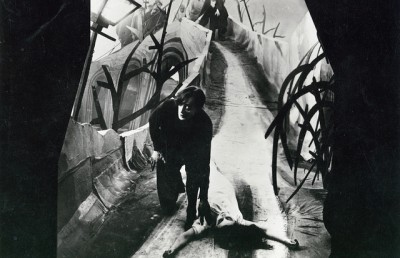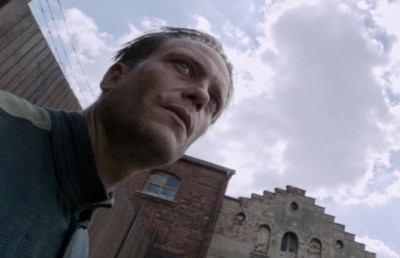A Hidden Life (Terrence Malick, 2019)
The Making of a Martyr
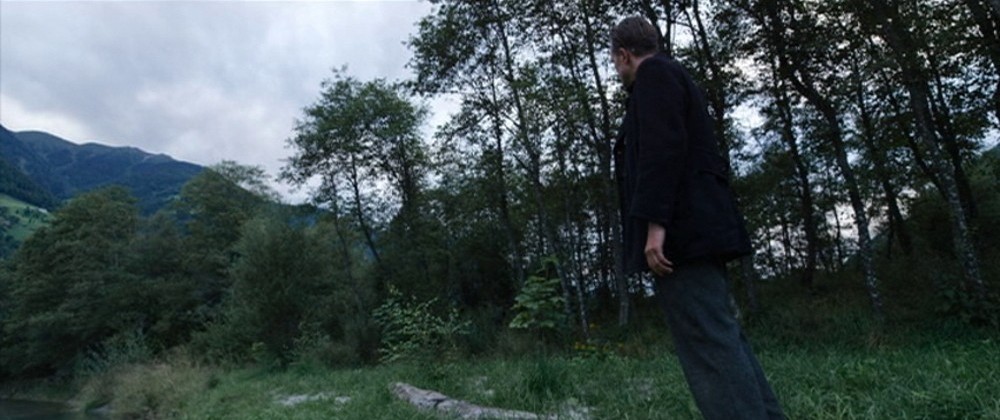
Malick’s latest film is also his most personal and overtly religious, without being ABOUT religion it is about one man’s challenge to remain true to his own spiritual belief, one that does not allow him to do something which he knows to be wrong. In this case we have a farmer living communally in the Austrian village of St. Radegund, who ends up doing something extraordinary, Franz Jägerstätter (played by Anton Diehl). Franz is married to an equally strong woman, Franziska Jägerstätter (Valerie Pachner), with whom he has three daughters. Malick’s story is based on true events and true characters. At the start of World War 2 Austria was under German authority and all Austrians were enforced to swear an oath of allegiance to Germany and the Führer, something that Jägerstätter never consented to, holding out as a conscientious objector at the expense of everything he held dear, his wife, three daughters, mother, land, life. The film is built on a forceful sense of determinism. As viewers we know that Franz will not budge from his firmly held belief, with an inexorability that gives the film a one-way path, often visualized through images of long dirt roads or prison corridors. This is undeniably a Terrence Malick film in its tone and style, with his trademark fluid wide angle Steadicam camera in constant movement and matched by a jagged, elliptical cutting style. But here his style is modulated, toned down as if in respect to the human dilemma and the powerful human spirit that touches down on the land and surrounding farmlands. Malick returns to the natural splendor of his second film, Days of Heaven, only here Nature is a conduit or expression of God.
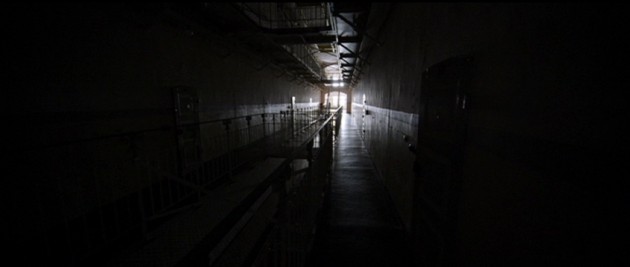
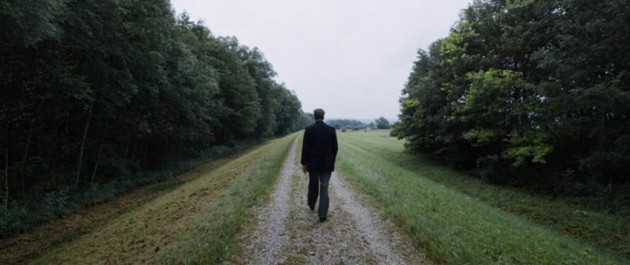
Single lined pathways
Franz serves a brief military service and then returns to his family, anxious of what the future holds. His strongly held pacifist beliefs spread throughout his small community of conservative and religious folk, and he becomes a pariah and his family ostracized. When he receives a letter ordering him back to the front he must take a hard decision: return for the sake of his family (even if it means he may die like his father did in WW1) or refuse and bear the consequences it will have on his family. His wife tries to convince him to serve in a hospital. Or to hide out in the woods, not a realistic proposal. Instead he enlists but at the first moment where he must perform a “Heil” to the Führer, he is caught out and arrested. From this point the film changes from the lighter, more uplifting quality of the first hour, where the camera divided its time between the gorgeous natural landscape of hills, trees, grass, mountains and fresh springs, caught in a Caspar David Friedrich-like painterly fog, and their lovely wood log farmhouse. For this first section the film recalls Tarkovsky’s Mirror (1975). Malick even recreates the famous final scene of the young couple lying together in the grass. And Sokurov’s even more painterly Mother and Son is also invoked. Once Franz is imprisoned and the communication between Franz and Franziska becomes restricted to letters and voice-overs, the film enters a more ascetic, Bressonian territory.
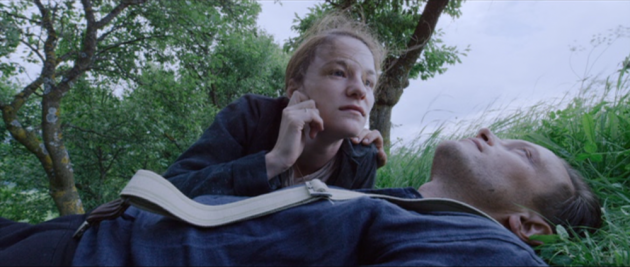
Homage to Mirror
There’s one shot in the early “lighter” section which marked the film for me, and reveals how Malick has conceived of this single man’s journey. In this scene at 26 minutes Franz is talking to the local, well intending priest who tries to convince Franz that his stance can only lead to death and that he should think about his family. “Don’t you think you should think about the consequences of your actions?” The priest cannot imagine that, in fact, this is ALL he has thought about! In this exchange, which takes place on a main country road with houses and mountains in the background, Franz is framed in profile and we can see a small patch of white hair just behind his left ear.
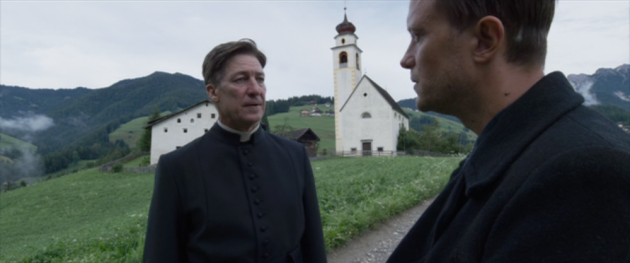
The Tarkovskian marking of Jesus Christ
Tarkovsky used this piece of make-up on many of his male characters, most notably Andrei Rublev in Andrei Rublev, the Stalker from Stalker and Andrei from Nostalghia, and spoke of how Christ also had that mark on his hair, so he granted to these often weak or imperfect characters the physical mark of unwilling Christ figures. Whether this patch of white hair is historically accurate or not with respect representations of Christ in art, it is what Tarkovsky believed and used in his aesthetic arsenal, and something that Malick is extending here. In this scene the priest is basically telling him that the consequences of his actions are so predictable that he is making a martyr of himself, foreshadowing the fact that the real Franz would be declared a martyr by the Catholic Church in 2007. (There have been many such Icons depicting him as such.) Hence the reference that Malick is making to Tarkovsky’s Christ figures is perhaps an homage or just his own aesthetic depiction of the man.
A follow-up scene about ten minutes later continues this connection to Tarkovsky and Christ in the scene where Franz visits the local artist painting a church. The painter’s thoughts echo the life of Andrei Rublev, who lived a sheltered life in a monastery until he left the safe enclave of his monastery to be exposed to humanity’s cruelness while travelling to paint a church in Moscow. The painter tells Franz, “Christ’s life is a demand. People just don’t want to be reminded of it. So we don’t have to see what happened to the truth. Darker times is coming….I paint all this suffering but I don’t suffer myself. I paint their comfortable Christ, with a halo over his head. How can I show what I haven’t lived? Someday I might have the courage to venture, not yet.” These profound words foreshadow Franz’s own path to come, suffering for his own beliefs. Malick’s approach to this story is to infuse his camera and the settings with heavy symbolism. When Franz is in prison he cuts continually between rigid, tall, claustrophobic concrete spaces that function like a cell around his spirit. In one sequence he reads a letter to his wife in voice-over while the camera mimics his souls ability to be not bound by the physical. The camera tracks forward along the prison hallways, corridors, pathways until finding a path that leads to light. As he tells the lawyer who tries to convince him to sign his oath of allegiance to Hitler he asks Franz: “Don’t you want to be free?” To which he replies, “I am.” And then another prophetic line: “It is better to be harmed by injustice than commit it.” Malick maintains a mostly linear progression, with some minor flashbacks to better times, but prolongs the end by intercutting between two different forms of suffering, Franz’s suffering in the prisons and Franziska at home alone, working herself to the bone and bearing the ugly, damning stares of her uncaring neighbors.
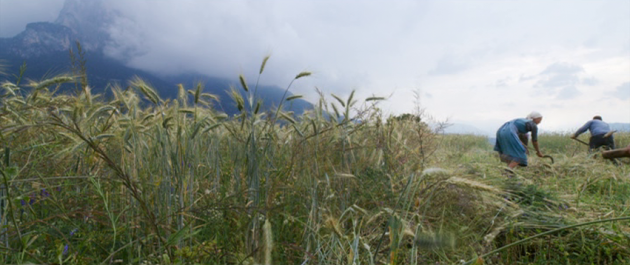
The one false note in the film, one which I am willing to patch over through interpretation, is the decision to have the Austrian and German characters speak mostly in English, but still have other characters speak in German. Most disconcerting, this duality happens even in the same scene, with one character speaking to Franz in English and to another in German. And the German is never translated or subtitled. Why does Malick decide to play the dialogue out in this schizophrenic manner? To not alienate American audiences, who are notoriously apathetic to reading subtitles? Certainly, the film would have felt far more organic and truthful to the real events if it had been spoken in German. The only way I can make aesthetic sense out of it is that by forcing most viewers to NOT understand the German, it becomes “nonsense”; and secondly, the German speech/English speech seems to have a moral side to it. It seems that the German is reserved for words of hate and anger, while the English words represent common sense dialogue and kindness. Indeed, many of the scenes in which German is spoken involve people yelling hatred at Franz. In all the scenes in prison when German officers yell, hit or intimidate Franz they speak in German. In fact, the only times Franz himself raises his voice or speaks in anger, it is in German. Some of the most iconic moments of Hitlerian speeches involve him yelling loudly and gesticulating like a “madman”. Even in The Great Dictator (1940) when Chaplin wanted to make fun of the Führer character he has him getting angry and frustrated and screaming madly at tiny inconveniences. The only exception to this is the scene where the Nazi sympathizing Mayor attacks Franz’s character in the town, in English, and he makes accusations of treason and anti-patriotism. But a few scenes later, at night, the mayor goes on a mad verbal tirade in German speaking to his citizens and German soldiers around a fire, perhaps meant to recall Hitler’s own mad speeches. One tellingly brief, seemingly inconsequential shot seems to bear only this point. It is night and very dark. The camera films the town from far away nestled within mountains. In the distance we hear one of Hitler’s famous angry speeches coming from a faraway radio, a few lights locate where the sound is coming from, as the image slowly fades to black.
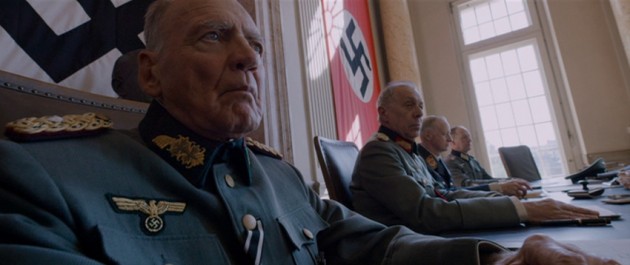
Bruno Ganz in his penultimate role
The most flagrant use of this German/Hatred, English/Compassion dichotomy comes in the Military hearing scene, where Franz is ultimately sentenced to death. While one angry German officer yells with terrible aggression and anger at Franz in German, a much more calm, high ranking Officer, played by Bruno Ganz as the Judge, speaks to Franz in a calming English voice. Ganz of course brings a certain solemnity to the role, since he famously played Hitler in Downfall and died shortly after he filmed his scenes. My point about Malick designating German as the language of madness gains some anecdotal weight if you consider that Ganz’s role in Downfall served as a template for a series of viral mashups that took the context of a nervous, haggard, manic Hitler in his final moments after realizing that his 1000 Year Reich would end prematurely, and replaced the audio with a slew of hilarious send-ups (Hitler angry for being made to watch The Room, or a Star Trek vs. the Borgs battle, or an animated version where Hitler is black, or Hitler rapping his tirade, etc.). Malick also invokes Hitler in the sporadic archival footage of Hitler that appears sprinkled throughout. But Malick estranges the archival scenes by faux black and white archival scenes, also framed in 4:3, of a steam train riding fast through the countryside, a scene which repeats and becomes framed as a recurring dream, one that we can read as a portentous sign of “darkness” ahead. Another false or overwrought device is the way Malick often frames the Nazi military figures in extreme wide angle lenses which make them feel inhumanly grotesque, a parody of the cliché ‘Ugly Nazi’.
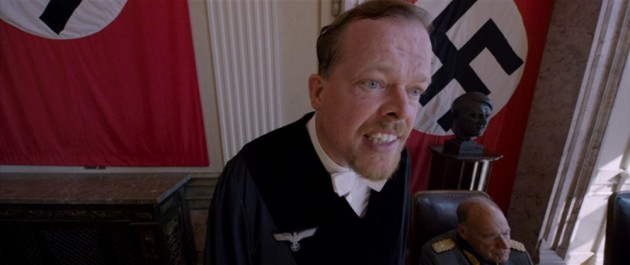
The ‘Ugly Nazi’
There is one scene which brought out a point I had always held about subjectivity in cinema, the use of point of view and the sometimes held critical belief that film by using the codes of subjectivity can place viewers in a like for like situation or feeling. Some theories hold the claim that when the camera assumes the point of view of a character, when the camera “sees” through the eyes of a protagonist, we somehow are better able to identify with that character, even to point of feeling something similar to them. In the case of Roger Ebert’s famous moral claim against slasher films and their noted killer’s POV, because they made us associate with a misogynistic position. At about 99 minutes into the film, Franz is finally, after many threats, beaten up by a German soldier. Malick films this beating in a style that is diametrically opposed to the rest of the film. The camera adopts or becomes Franz, and the soldier seems to be attacking the camera. As Franz is hit and falls, the camera drops to the ground, the camera shakes as if being hit, we even see Franz’s legs in the frame as the soldier pulls him along the ground. The fight is frenetic and violent; however, did I feel like I WAS being hit. No, not at all. Did it feel violent? Yes as a movement but not as an act of violence. In fact the violence was much easier to watch through this first person position than if the camera would have been looking AT Franz from the German’s POV. With this ‘all-first-person subjective’ position we do not see Franz being hit, bleeding, in pain, etc. So using a subjective POV angle does not necessarily make us feel more involved in the action. And clearly it does not make us feel as if we are IN the action. Contrary to the claim often made by professional critics (and students) in their writing, “the camera made me feel like I was right there with the character”. (Really?) My sense is that Malick chose this way to film the beating to a) save audiences from seeing the actual impact, blood, gore and violence of the attack (and keeping the film at a PG-13 rating) and b) keeping the onus on the violent gestures and action of the German soldier doing the beating.
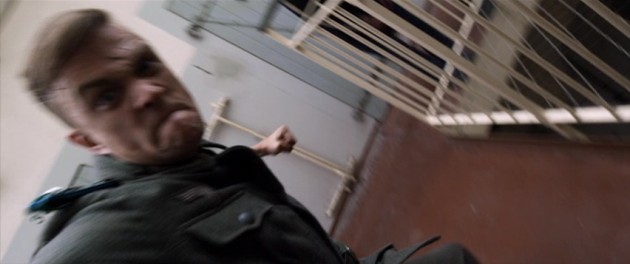
Do you feel Franz’s pain?
The film gains its true power from the excruciating cross that Franz bears, and the difficult decisions he has to make. The film raises deep philosophical questions about life’s difficult choices and a person’s duty to state, family and personal belief. Should one choose the well- being of loved ones over one’s firmly held ideals? Does personal belief, whether couched in religion or morality, take precedence over civic or National duty? Once Franz decides that he cannot swear an allegiance to the Nazi ideology because he sees it as an equivalence of the anti-Christ, he both searches out guidance and receives it unwillingly.
As a younger boy I always reserved evil for the world of monsters and the supernatural. But as I got older I realized that humanity was not immune to evil and that evil as a concept can spread to the natural world. In most religions God is Good and the Devil is the Evil counterpoint, maintaining the evil as supernatural view. But in A Hidden Life the word Anti-Christ is used several times by Franz and priests to designate not Satan but Hitler as the Anti-Christ. Hitler becomes in Franz’s mind Satan on earth and his sacrifice is partly a repeat of Christ’s death on the cross for the sins of others. Franz dies to atone for the sins of the Nazis. At least that is one way of reading his journey, a journey which takes him further and further along a path of loneliness (noted repetition of shots of singular, long hallways and paths). Everyone takes a stab at trying to convince Franz to change his mind: his wife, his mother, his mayor and community leaders, the priest and the Church, judges, lawyers and friends. But in the end, even after his wife travels to Berlin to meet him in prison with the town priest and lawyer, he does not bend. His implacable allegiance to his moral and political ideal is at once awe-inspiring, frightening, terrifying, frustrating, yet ultimately all we can do is marvel at his inner strength. In a beautiful moment, his wife, knowing this will in all likelihood be the last time she sees him alive, tells him that she loves him and will stand by him, whichever decision he takes. The image of Franz’s loneliness is perhaps reflected in the odd moments across the film where either Franz or Franziska see a hermit-like man rustling about the woods, spying, looking for human contact, then running away when his eyes meet another. The status of this feral man, cut off from society, is never explained —maybe another conscientious objector— hence can be read as a symbolic analog for Franz, who himself even suggests that he can hide out in the woods after being called to military service.
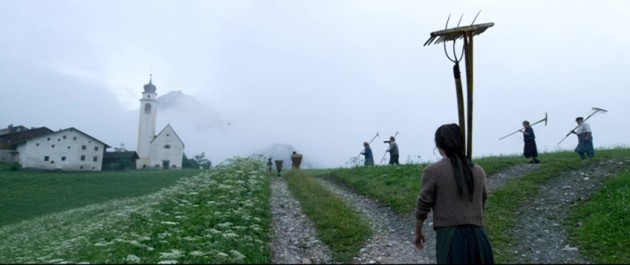
Return to Paradise
Once Franz is executed, we feel deeply for Franziska, but the film ends with an uplift, returning us to the “Paradise” of his farmland, with his wife and sister tilling the land, shearing the sheep, continuing the work they did together. Franziska and her mother-in-law painting the house. A happy wedding, an old man giving Franz’s youngest a drink of water (reconciliation?) in the town. Farmers carrying tools over their shoulders walking majestically toward the fields. The swelling classical orchestral score (Arvo Pärt, Henryk Górecki and Johann Sebastian Bach, Beethoven) increases the emotional weight; her words, “Franz, I’ll meet you there, in the mountains,” as the camera cranes up to frame the gorgeous mountains in the distance. Franziska must have suffered and felt great pain after Franz died in 1943 at the age of 36; but the real Franziska lived for another 60 years, dying at the age of 100 in 2013.
Malick captures the quiet grandeur and importance of Franz’s life in a concluding quote from George Eliot:
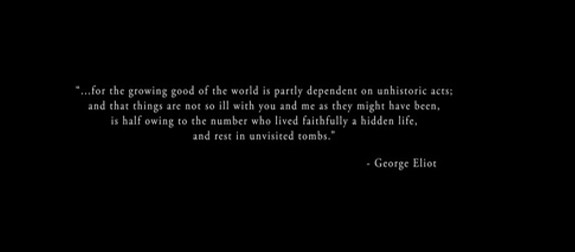
George Eliot
“…for the growing good of the world is partly dependent on unhistoric acts;
And that things are not so ill with you and me as they might have been,
Is half owing to the number who lived faithfully a hidden life,
And rest in unvisited tombs”



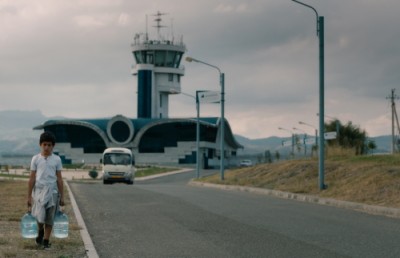
-small_400_258_90_s_c1.jpg)
